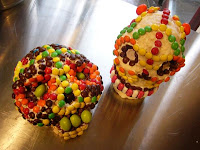Fun sweets as such and treats are in no doubt to gratify your Halloween party-goers and the modest munchkins on your doorstep. Or you can wrap up a variety of the sweets and give them out as Halloween gifts to your friends and family. Carry a number of Halloween spirit to the office with any of these fun to make treats and get the kids involved for some family time in the kitchen.
Candy Skulls

Festooned folk-art confections from Mexico are used to celebrate "Day of the Dead", a Mexican fête of those who have passed on. They are made of pressed sugar and decorated with icing. Some people also affix foil or other non-edible decorations to enhance the finished art. Follow the directions in this Candy Skulls Step-by-Step and have fun making your own folk-art skulls.
Disengaged Fingers
The Guide to Candy has come up with a gruesome candy treat that looks just like Severed Fingers. These Marzipan fingers are the ultimate ghoulish Halloween candy made with delicious almond marzipan that is fashioned into frighteningly lifelike severed fingers.
Cupcakes

Appetizing pumpkin cupcakes that you can decorate however you like. She includes a few ideas in this easy Cupcake Recipe. Try gummi worms and cookie crumbs for dirt or gummi spiders and pumpkins. Kids will have a great time making and eating these delicious Halloween treats.
Spiders in Candy form.Chocolate Cupcakes is also very good in taste.
Amazingly spooky is swarming up your arm, one can hope of these deliciously crunchy Candy Spiders
made with chow-mein noodles and nuts. The recipe is from our Guide to Southern Food and can be made in chocolate or butterscotch flavors.
Mice in Chocolate and cherry flavour

Lastly, a mouse you won't mind finding around the house. These little squeaky treats are fun for the kids to make and you can follow along with these easy Step-by-Step instructions from our Guide to Homecoming. They are so cute you may not want to eat them, but once you have a taste, good luck trying to stop yourself.
Candied Apples

Ever since apples are at their peak in the fall, these chewy and fruity treats are perfect timing for Halloween. Everyone loves these candy covered fruits and this Candied Apple Recipe from our Guide to Desserts and Baking will have you enjoying the fruits of fall in no time.
Candy Skulls

Festooned folk-art confections from Mexico are used to celebrate "Day of the Dead", a Mexican fête of those who have passed on. They are made of pressed sugar and decorated with icing. Some people also affix foil or other non-edible decorations to enhance the finished art. Follow the directions in this Candy Skulls Step-by-Step and have fun making your own folk-art skulls.
Disengaged Fingers
The Guide to Candy has come up with a gruesome candy treat that looks just like Severed Fingers. These Marzipan fingers are the ultimate ghoulish Halloween candy made with delicious almond marzipan that is fashioned into frighteningly lifelike severed fingers.
Cupcakes

Appetizing pumpkin cupcakes that you can decorate however you like. She includes a few ideas in this easy Cupcake Recipe. Try gummi worms and cookie crumbs for dirt or gummi spiders and pumpkins. Kids will have a great time making and eating these delicious Halloween treats.
Spiders in Candy form.Chocolate Cupcakes is also very good in taste.
Amazingly spooky is swarming up your arm, one can hope of these deliciously crunchy Candy Spiders
made with chow-mein noodles and nuts. The recipe is from our Guide to Southern Food and can be made in chocolate or butterscotch flavors.
Mice in Chocolate and cherry flavour

Lastly, a mouse you won't mind finding around the house. These little squeaky treats are fun for the kids to make and you can follow along with these easy Step-by-Step instructions from our Guide to Homecoming. They are so cute you may not want to eat them, but once you have a taste, good luck trying to stop yourself.
Candied Apples

Ever since apples are at their peak in the fall, these chewy and fruity treats are perfect timing for Halloween. Everyone loves these candy covered fruits and this Candied Apple Recipe from our Guide to Desserts and Baking will have you enjoying the fruits of fall in no time.

